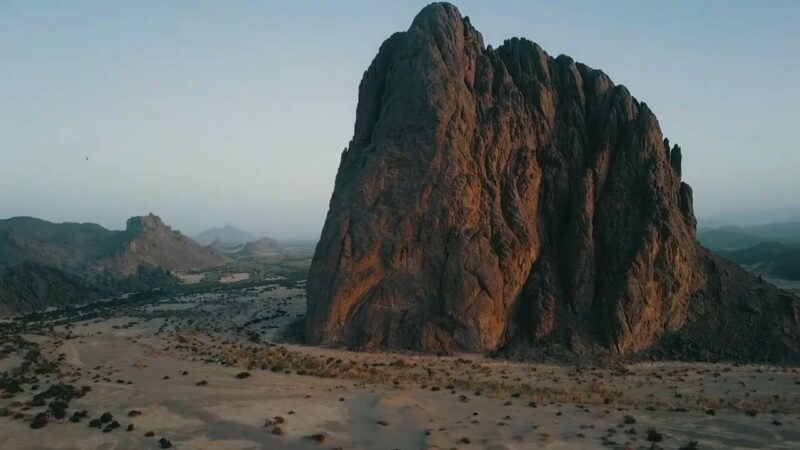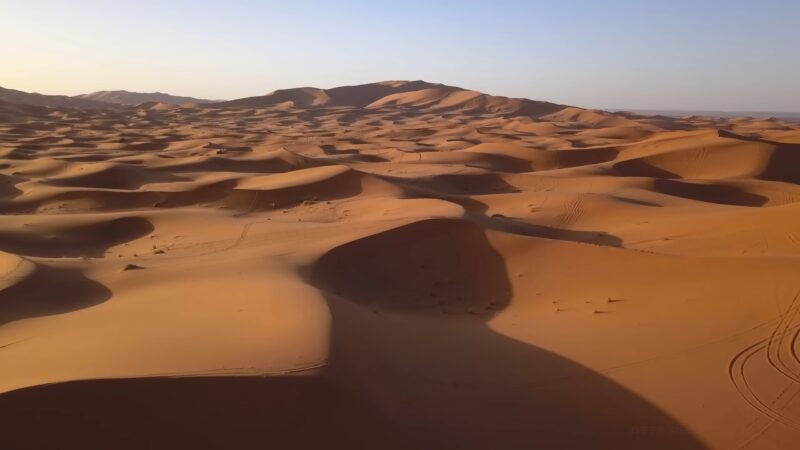Africa, the second-largest continent in the world, is a land of contrasts. From its lush rainforests to its expansive savannas, it’s a continent that never ceases to amaze.
But perhaps some of its most intriguing landscapes are its deserts. These vast stretches of sand and rock are not just barren wastelands; they are teeming with life, history, and stories waiting to be told.
Let’s embark on a journey across the ten largest deserts in Africa.
1. Sahara Desert
The Sahara, a vast golden sea of sand, stretches over 9 million square kilometers, making it the world’s largest hot desert. It blankets 11 North African countries, creating a natural barrier that has influenced trade and cultural exchange for millennia.
The Sahara’s daytime temperatures can be scorching, often exceeding 30°C, but as the sun sets, the desert can become surprisingly cold, with temperatures plummeting below freezing. The desert’s landscape is not monotonous; it’s dotted with iconic sand dunes, some of which tower up to 180 meters, resembling golden waves frozen in time.
But the Sahara is not just about sand. It’s a biodiverse region, home to camels, often dubbed the “ships of the desert,” and various reptiles like snakes and lizards. Amidst its arid expanse lie oases, verdant patches that sustain life and have been hubs of human civilization for ages.
Interesting fact
The Sahara Desert is expanding. Due to a combination of natural climate cycles and human activities, the Sahara has grown by about 10% over the last century, making it even more vast and formidable.
2. Kalahari Desert
The Kalahari, a vast expanse of reddish sand, covers over 930,000 square kilometers, making it Africa’s second-largest desert. This desert sprawls across southern Africa, touching Botswana, Namibia, South Africa, and even reaching into Angola.
Unlike the Sahara, the Kalahari is classified as a semi-arid desert. Its temperatures hover around 25°C, but its ecosystem is surprisingly diverse. This desert is a sanctuary for Africa’s iconic wildlife. Elephants, with their majestic tusks, roam its expanse, as do the regal lions and graceful giraffes.
The Kalahari is also home to indigenous communities like the San and Khoisan, who have lived in harmony with this challenging environment for thousands of years. One of the Kalahari’s most mesmerizing sights is its salt pans, vast white expanses that shimmer under the African sun.
Interesting fact
The Kalahari Desert is home to the “Lost City of the Kalahari,” a legendary city which explorers in the 19th century claimed to have discovered but has never been found again, making it one of the great unsolved mysteries of the desert.
3. Namib Desert
The Namib, with its hauntingly beautiful landscapes, is believed to be the world’s oldest desert, having endured for over 80 million years. Located in southwestern Africa, it hugs the coast of Namibia. The desert’s proximity to the ocean means it’s often shrouded in a thick fog, a gift from the cold Benguela current.
This fog is a lifeline, providing much-needed moisture to the desert’s unique flora and fauna. Creatures like the Namib Desert beetle have evolved astonishing adaptations to survive here.
The beetle harvests water from the morning fog, a testament to nature’s ingenuity. Dominating the Namib’s landscape are the Sossusvlei sand dunes.
These dunes, some of the world’s highest, are a riot of oranges and reds, creating a surreal landscape that attracts photographers and travelers from around the world.
Interesting Fact
The Namib Desert is home to some of the world’s oldest plants, the Welwitschia mirabilis. Some of these plants are estimated to be around 2,000 years old and have only two leaves that grow continuously throughout their life.
4. Karoo Desert
The Karoo, South Africa’s hidden gem, is divided into the vast Great Karoo and the more compact Little Karoo. This semi-arid region, where temperatures average around 20°C, is a mosaic of rugged hills, vast plains, and deep valleys.
The Karoo’s biodiversity is astounding. It’s home to a plethora of succulents, many of which are found nowhere else on Earth. Grazing on its plains are antelopes, and the skies above are often dotted with birds of prey.
One of the Karoo’s treasures is the Cango Caves. Located near the town of Oudtshoorn, these caves are a subterranean wonderland. Stalactites and stalagmites, formed over millions of years, create intricate formations that leave visitors in awe.
The caves, with their cool interiors, offer a respite from the desert’s heat and are a testament to the wonders that often lie just beneath our feet.
Interesting Fact
The Karoo Desert has a unique phenomenon called the “Karoo Koppie.” These are small hills that are home to a diverse range of plant species not found in the surrounding areas, making each koppie a mini ecological island.
5. Danakil Desert
The Danakil Desert in Ethiopia is often described as a place where the Earth shows its raw power. As one of the hottest and driest places on the continent, it lies a staggering 125 meters below sea level.
This depression has given rise to a landscape that seems almost otherworldly. Volcanic activity is rampant here, with Erta Ale being one of its most active volcanoes, continuously spewing molten lava.
The Dallol crater, a highlight of the desert, is a canvas of vibrant colors. Its hot springs, tinged with greens, yellows, and blues due to the minerals, contrast starkly with the white salt lakes. This desert is not just a testament to nature’s extremes but also to human resilience, as the Afar people have called this harsh environment home for centuries.
Interesting Fact
The Danakil Desert houses the “Gateway to Hell,” a nickname for the Erta Ale volcano. It has one of the world’s few persistent lava lakes, which has been active for decades.
6. Chalbi Desert
Nestled in northern Kenya, the Chalbi Desert is a landscape of contrasts. While its vast salt pans shimmer under the African sun, remnants of ancient lava flows tell tales of a fiery past.
The desert, though seemingly inhospitable, teems with life. Zebras graze on its sparse vegetation, camels traverse its expanse, and ostriches sprint across its plains.
The Borana people, with their deep-rooted traditions, have adapted to the Chalbi’s challenges, showcasing the harmonious coexistence of man and nature.
Interesting Fact
The Chalbi Desert was once a large lake. Over time, as the waters receded, they left behind vast salt pans that now characterize much of the desert’s landscape.
7. Libyan Desert
The Libyan Desert, a vast expanse within the Sahara, is one of the driest places on Earth. Rainfall is a rare event, and water sources are few and far between.
Yet, this North African desert is a marvel. Towering sand dunes, some resembling golden mountains, dominate the landscape.
The desert’s salt flats, with their crystalline structures, and oases, like the Siwa Oasis, are pockets of life amidst the aridity. Hidden within its sands are relics of the Roman Empire, silent witnesses to the caravans that once traversed this desert.
Interesting Fact
The Libyan Desert holds the record for the highest ground temperature ever recorded on Earth. In 1922, a temperature of 58°C (136.4°F) was recorded at Al Aziziyah.
8. Nubian Desert

The Nubian Desert, lying between the Nile River and the Red Sea, is a vast sandy expanse. While it’s a part of the larger Sahara, it has its own unique identity.
Mountains rise from its plains, valleys carve their way through its heart, and oases dot its expanse. But the Nubian Desert is not just about its natural beauty; it’s a repository of history.
Ancient ruins, remnants of the Nubian civilization, are scattered across the desert, telling tales of a time when this arid land was a cradle of culture and trade.
Interesting Fact
The Nubian Desert has ancient rock drawings and carvings at sites like Sabu and Wadi Sura, offering a glimpse into the lives of prehistoric communities that once inhabited the region.
9. Somali Desert
Stretching across the eastern part of Africa, the Somali Desert is a defining feature of the Horn of Africa. Known for its sweltering heat, this desert is a challenging environment.
Yet, it’s teeming with life. Camels, the lifeline of many nomadic tribes, tread its sands, while snakes and lizards lurk in its shadows.
The Somali people, with their rich traditions and nomadic lifestyle, have been intertwined with this desert for generations. Their songs, stories, and way of life are deeply influenced by the rhythms of this arid land.
Interesting Facts
The Somali Desert is home to the Laas Geel rock art, a series of ancient cave paintings dating back 5,000 years. These well-preserved artworks depict cattle, wild animals, and human figures and are considered one of the best-preserved rock paintings in Africa.
The Importance of African Deserts
Deserts are not just barren landscapes; they play a crucial role in our planet’s ecology. They are biodiversity hotspots, carbon sinks, and play a pivotal role in the global water cycle.
Culturally, they have been cradles of civilization, trade routes, and spiritual centers. Economically, they offer resources ranging from minerals to tourism opportunities.
However, these fragile ecosystems face threats from climate change, overgrazing, and human activities. Conservation is not just essential; it’s imperative.
As we stand at the crossroads of history, it’s up to us to decide the fate of these majestic landscapes.
FAQ
How many deserts are there in South Africa?
South Africa is home to three unique deserts: a part of the Kalahari Desert, a part of the Namib Desert, and the entire Karoo Desert.
Are there any deserts in Africa that aren’t true deserts?
Some academics argue that the Kalahari, due to parts of it receiving more than 10 inches of rain annually, isn’t a true desert. However, it’s still widely recognized as one.
Which desert is known for its multi-colored salt lakes?
The Danakil Desert is known for its impressive multi-colored salt lakes.
Are there any deserts in Africa that are popular tourist destinations?
Yes, the Lompoul desert in Senegal is a popular tourist destination due to its large orange sand dunes.
Which desert has the highest dunes on the planet?
The Namib Desert boasts some of the planet’s highest dunes, reaching over 300 meters.
Closing Thoughts
Africa’s deserts are a testament to the resilience of life and the indomitable spirit of the people who call them home. As we journey through these vast landscapes, we are reminded of the beauty and fragility of our planet.
Let’s cherish and protect these natural wonders for generations to come.
Related Posts:
- 17 Ugliest Fish in the World - Pics, Videos,…
- 10 Mountains To Hike In East Africa 2024 - Scaling…
- What Habitats Do Mammals Live In? From Forests to Deserts
- 10 Biggest Jungle Animals: Iconic Species Facts & Pics
- White-Lipped Tree Frog - Pictures, Videos and…
- African Animals - Interesting Facts and Pictures








